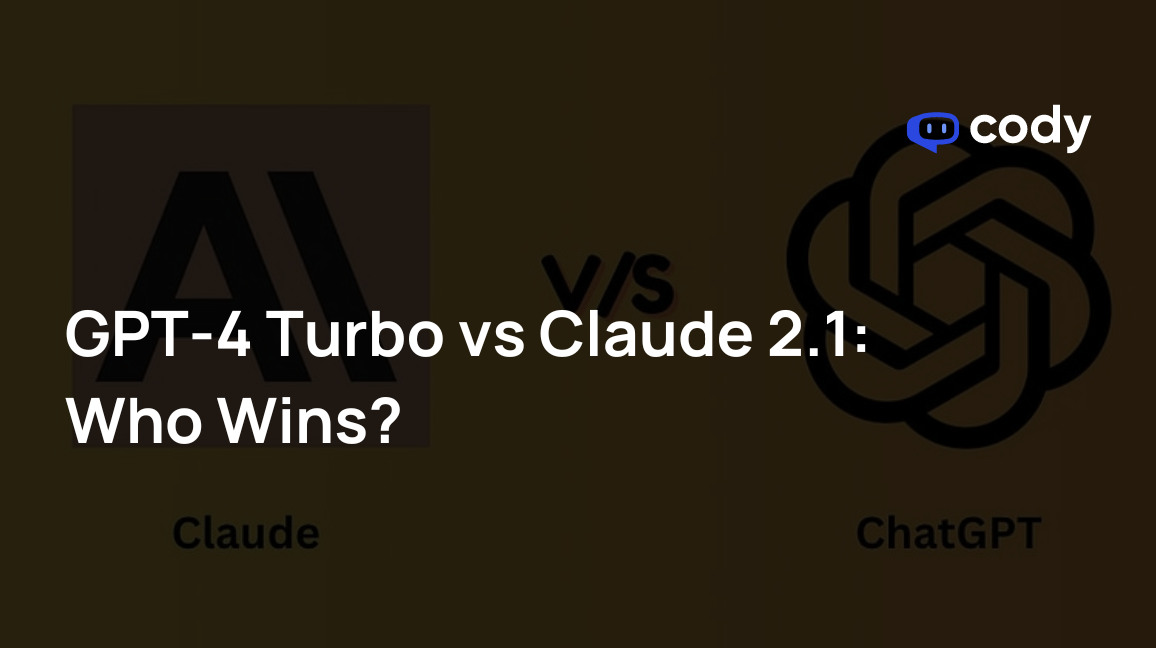
Today, when we think of artificial intelligence, two main chatbots come to our mind- GPT 4 Turbo by OpenAI and Claude 2.1 by Anthropic. But who wins the GPT 4 Turbo vs Claude 2.1 battle?
Let’s say you’re selecting a superhero for your team. GPT 4 Turbo would be the one who’s really creative and can do lots of different tricks, while Claude 2.1 would be the one who’s a master at dealing with huge amounts of information.
Now, we’ll quickly understand the differences between these two AI models.
Read on.
GPT 4 Turbo vs Claude 2.1 — 10 Key Comparisons
Here are 10 criteria to decide between GPT 4 Turbo vs Claude 2.1:
Pricing models
The pricing models and accessibility to GPT-4 Turbo and Claude 2.1 vary significantly.
While one platform might offer flexible pricing plans suitable for smaller businesses, another might cater to larger enterprises, impacting user choices based on budget and scalability.
Quick tip: Please select any model depending on your needs and budget.
User interface
GPT-4 Turbo offers a more user-friendly interface, making it easier for users who prefer a straightforward experience.
On the other hand, Claude 2.1’s interface could be designed for experts needing tools tailored specifically for in-depth textual analysis or document summarization.
Complexity handling
When presented with a lengthy legal document filled with technical jargon and intricate details, Claude 2.1 might maintain better coherence and understanding due to its larger context window. At the same time, GPT-4 Turbo might struggle with such complexity.
Generally, lengthy documents with details are better for Claude, as GPT focuses more on the creative side.
Adaptability and learning patterns
GPT-4 Turbo showcases versatility by adapting to various tasks and learning patterns.
For instance, it can generate diverse outputs—ranging from technical descriptions to poetic verses—based on the given input.
Claude 2.1, on the other hand, may predominantly excel in language-centric tasks, sticking closer to textual patterns.
Content window size
Imagine a book with a vast number of pages.
Claude 2.1 can “read” and understand a larger portion of this book at once compared to GPT-4 Turbo.
This allows Claude 2.1 to comprehend complex documents or discussions spread across more content.

Knowledge cutoff date
GPT-4 Turbo might better understand current events, such as recent technological advancements or the latest news, due to its knowledge reaching up until April 2023. In contrast, Claude 2.1 might lack context on these if it occurred after its knowledge cutoff in early 2023.
Language type
GPT-4 Turbo can assist in coding tasks by understanding programming languages and providing code suggestions.
On the flip side, Claude 2.1 is adept at crafting compelling marketing copy or generating natural-sounding conversations.
Real-time interactions
In a live chat scenario, GPT-4 Turbo generates quick, varied responses suitable for engaging users in a conversation.
On the other hand, Claude 2.1 might prioritize accuracy and context retention, providing more structured and accurate information.
Ethical considerations
GPT-4 Turbo and Claude 2.1 differ in their approaches to handling biases in generated content.
While both models undergo bias mitigation efforts, the strategies employed vary, impacting the fairness and neutrality of their outputs.
Training time
GPT-4 Turbo requires longer training times and more extensive fine-tuning for specific tasks due to its broader scope of functionalities.
Claude 2.1, on the other hand, has a more focused training process with faster adaptability to certain text-based tasks.
Best GPT-4 Turbo Use Cases
Here are the best ways to use GPT-4 Turbo:
Coding assistance
GPT-4 Turbo shines in coding tasks and assisting developers.
It’s an excellent fit for platforms like Github Copilot, offering coding suggestions and assistance at a more affordable price point compared to other similar tools.
Visualization and graph generation
Paired with the Assistants API, GPT-4 Turbo enables the writing and execution of Python code, facilitating graph generation and diverse visualizations.
Data analysis and preparation
Through features like Code Interpreter available in the Assistants API, GPT-4 Turbo helps in data preparation tasks such as cleaning datasets, merging columns, and even quickly generating machine learning models.
While specialized tools like Akkio excel in this field, GPT-4 Turbo remains a valuable option for developers.
Best Claude 2.1 Use Cases
Here are the best ways to use Claude 2.1:
Legal document analysis
Claude 2.1’s larger context window makes it ideal for handling extensive legal documents, enabling swift analysis and providing contextual information with higher accuracy compared to other Language Model Models (LLMs).
Quality long-form content generation
With an emphasis on input size, Claude 2.1 proves superior in generating high-quality long-form content and human-sounding language outputs by leveraging a broader dataset.
Book summaries and reviews
If you require summarizing or engaging with books, Claude 2.1’s extensive context capabilities can significantly aid in this task, providing comprehensive insights and discussions.
GPT 4 Turbo vs Claude 2.1 in a Nutshell
- GPT-4 Turbo has multimodal capabilities to handle text, images, audio, and videos. Good for creative jobs.
- Claude 2.1 has a larger context window focused on text. Great for long documents.
- GPT-4 Turbo deals with different things, while Claude 2.1 is all about text.
- Claude 2.1 understands bigger chunks of text—200k tokens compared to GPT-4 Turbo’s 128k tokens.
- GPT-4 Turbo’s knowledge goes until April 2023, better for recent events. Claude 2.1 stops in early 2023.
So, GPT-4 Turbo handles various stuff, while Claude 2.1 is a text specialist.
Remember, choosing the right model depends massively on your needs and budget.
Read More: OpenAI GPT-3.5 Turbo & GPT 4 Fine Tuning

